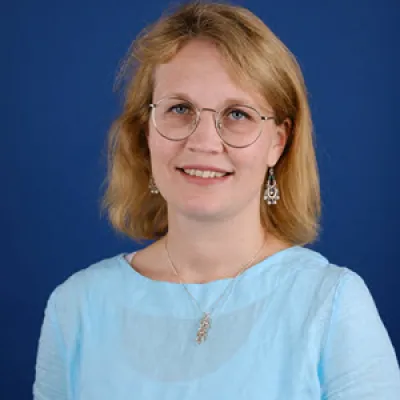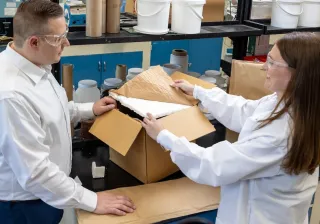Yvonne Nygård is passionate about researching how to solve major climate change-related problems through biotechnology. Her vision is to enable the development of the bioindustry to a position comparable to any other industry. She believes VTT and Finland can take a significant role in the field, both as developers and industrialisers.
Read the summary
- Finland is leading the bioeconomy development due to long-term research, renewable resources, and facilities like the Biofoundry at VTT, which enhance biotechnology processes through synthetic biology and automation.
- Nygård believes that biotechnology's future includes creating a new bioindustry sector to replace crude oil, using alternative raw materials, and leveraging carbon dioxide to reduce emissions.
- Artificial intelligence is revolutionising biotechnology by improving data analysis and process development, with significant progress seen in the application of gene editing tools like CRISPR for genetic modification in organisms.
This summary is written by AI and checked by a human.
VTT has made Yvonne Nygård's biotechnology research professorship permanent. She started in a fixed-term position in 2023.
"I think it's wonderful that VTT wants to further strengthen my own research area, which is seen as an important part of the transition to a bioeconomy. As a researcher, I naturally find it fantastic to be able to study what interests me most: how to solve major problems related to climate change," says Nygård.
VTT was the starting point of her career, where she completed both her master's thesis and doctoral dissertation. After her PhD, she moved to the Netherlands to work at the biotechnology company DSM for several years, while also working at the University of Groningen.
"It was a good and useful experience working with research and innovation in the business world. There, research doesn't go as deep; instead, the focus is on solving problems and increasing productivity," Nygård describes.
From the Netherlands, her journey continued to Sweden with a professorship at Chalmers University of Technology in Gothenburg, where she conducted basic research from an applied perspective. After seven years, it was time to return to the roots of her career path.
"VTT has always been a good workplace for me. In fact, when I left for the Netherlands, I had the idea of taking a leave of absence from VTT."
The development of biotechnology needs acceleration
Yvonne Nygård estimates that Finland is at the forefront of bioeconomy development, particularly thanks to long-term research and abundant renewable natural resources. Additional advantage comes from the fact that Finland has increasingly available renewable energy for the needs of environmentally friendly processes.
"At VTT, our research environment and investments in both piloting and small-scale performance, the so-called Biofoundry equipment and data management, offer world-class facilities for research work," Nygård gladly says.
The Biofoundry is a development platform that significantly accelerates the design, construction, and optimisation of biological processes and production organisms. Biofoundries combine synthetic biology, automation, and computational tools.
In biotechnology, Nygård is inspired by the goal of building an entirely new bioindustry sector that produces, among other things, materials that replace crude oil on an industrial scale.
"There's still a long way to go before bioindustry is comparable to any other industry. Many factors are slowing it down, starting with the fact that biotechnology development takes time. At VTT, we want to accelerate development and make impactful breakthroughs in the field. It requires a lot of action if we want to get rid of crude oil use," explains Nygård.
Another challenge in bioeconomy is that using sugars as a key raw material for biomass competes with food production. Therefore, it is essential to find biomass that utilises alternative raw materials in its production.
"The use of carbon dioxide will play a central role in the future, which also brings the advantage that we could simultaneously use and reduce carbon emissions."

Artificial intelligence is revolutionising biotechnology
Already in 2023, Nygård anticipated that artificial intelligence would revolutionise research in the field, for example, in processing data on the structure and function of microbes and in process development. This has indeed happened, as she says AI advances in biotechnology development occur almost daily, and new methods are quickly becoming available.
Artificial intelligence is now being used, for example, to analyse data from bioprocesses. Currently, the entire research field is intensely exploring how to standardise work methods and research data so that the data would be in a format usable for AI.
"Of course, it remains to be seen where exactly artificial intelligence will ultimately deliver the greatest advantage in biotechnology. We researchers also need to learn how to use AI more effectively.”
One of the highlights of Nygård's career has been the development of tools for gene editing: the application of CRISPR, or the gene scissors method, to the genetic modification of filamentous fungi is a study that has received many citations.
"The research focused on a species of mould widely used in biotechnology and a type of gene scissors that can be used to modify the genome. It has been gratifying to see that the developed tools are now widely used when modifying different moulds," says Yvonne Nygård.







